Sumida River
The Sumida River (隅田川 Sumida-gawa) is a river that flows through Tokyo, Japan. It branches from the Arakawa River at Iwabuchi and flows into Tokyo Bay. Its tributaries include the Kanda and Shakujii rivers.
What is now known as the "Sumida River" was previously the path of the Ara-kawa. However, towards the end of the Meiji era work was carried out to divert the main flow of the Ara-kawa to prevent flooding.
It passes through the following wards of Tokyo:
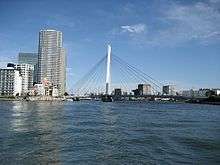
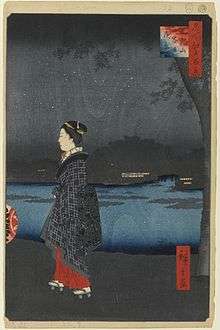
Culture
The Noh play Sumida-gawa, which the British composer Benjamin Britten saw while visiting Japan in 1956, inspired him to compose Curlew River (1964), a dramatic work based on the story.
The kabuki play, Sumida-gawa — Gonichi no Omokage, is perhaps better known by the title Hokaibo, which is the name of the central character. This stage drama was written by Nakawa Shimesuke, and it was first produced in Osaka in 1784. The play continues to be included in kabuki repertoire in Japan; and it is also performed in the West. It was recreated by the Heisei Nakamura-za in the Lincoln Center Festival in New York in the summer of 2007, with Nakamura Kanzaburō XVIII leading the cast.[1]
The Sumida River Fireworks, which are recognized as one of the oldest and most famous firework displays in Japan, are launched from barges across the river, between Ryōgoku and Asakusa during Summer, a festival is also held at the same time.
Literature
The poet Matsuo Bashō lived by the Sumida River, alongside the famous banana tree (Japanese: bashō) from which he takes his nom de plume.[2]
The Sumida River appears in a haiku by Issa from 1820:
spring peace--
a mouse licking up
Sumida River
Sumida bridges
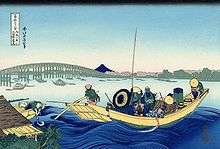
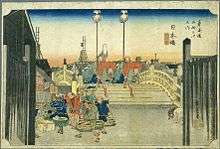
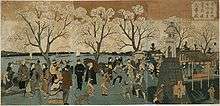

The Sumida runs through Tokyo for 27 kilometers, under 26 bridges spaced at about one bridge per kilometer. Amongst these, the principal ones are:
- The Ryōgoku-bashi (Ryōgoku Bridge), dating from 1932, replaced a bridge built in 1659. This bridge was immortalized many times by Hiroshige.
- The Nihonbashi or Nihon bridge, dating from the 17th century, was the bridge at which the Naksendō and Tōkaidō terminated (or the place from which they were said to have begun) during the Edo period. In those days, this bridge was called the Edo-bashi or Edo Bridge. (Nihon-bashi does not actually cross the Sumida River. It crosses the Nihonbashi River, about 1 kilometer west of the Sumida.)
- The Eitai-bashi (Eitai Bridge), dating from 1924, replaces a bridge built in 1696.[3][4]
- The Senju Bridge, dating from 1921, replaced an earlier bridge initially constructed in 1594, which was for a long time the only bridge across the river.
- The Sakura Bridge, dating from 1985.--link to recent, digitized photograph of Sakurabashi
- The Kototoi Bridge, dating from 1928, was reconstructed at the location of the bridge which linked two nearby temples—the Mimeguri-Jinja and the Matsuchiyama-shoden.-- link to recent, digitized photograph of Kototoi Bridge
- The Azuma Bridge, dating from 1931, replaced the bridge which was first built in 1774. This bridge is closest to Asakusa Station and the Kaminari-Mon.-- link to digitized image of Meiji-era postcard featuring Azuma Bridge
- The Komagata Bridge, dating from 1927, takes its name from the Matsugata temple dedicated to Bato-Kanon.-- link to recent, digitized panorama photo of Komagata Bridge in foreground and Azuma bridge in background
- The Umaya Bridge, dating from 1929, replaced a bridge built in 1875.
- Kuramae-bashi, built in 1924.[5]
- The Shin Ohashi (New Bridge), dating from 1976, replaced a bridge built in 1693. This bridge was not far from the Ryōgoku Bridge.[3]-- link to recent, digitized photograph of Shin Ohashi Bridge
- The Kiyosu Bridge, built in 1928 after the model of the Deutz Suspension Bridge of Cologne, links Kiyosu with Nihonbashi-Nakasu.[4][6]
- The Chuo Bridge, dating from 1994, is the most recently built of the bridges across the Sumida. See photo here
- The Tsukuda Bridge, dating from 1964,[7] was the first bridge built after World War II, crossing the river from Tsukiji to Tsukishima.
- The Kachidoki Bridge was constructed in 1940 for the commemoration of the victory of the Japanese army at Lushun during the Russo-Japanese War. This bridge is the only drawbridge on the Sumida, and has not been raised since 1970.-- link to recent, digitized photograph of Kachidoki Bridge
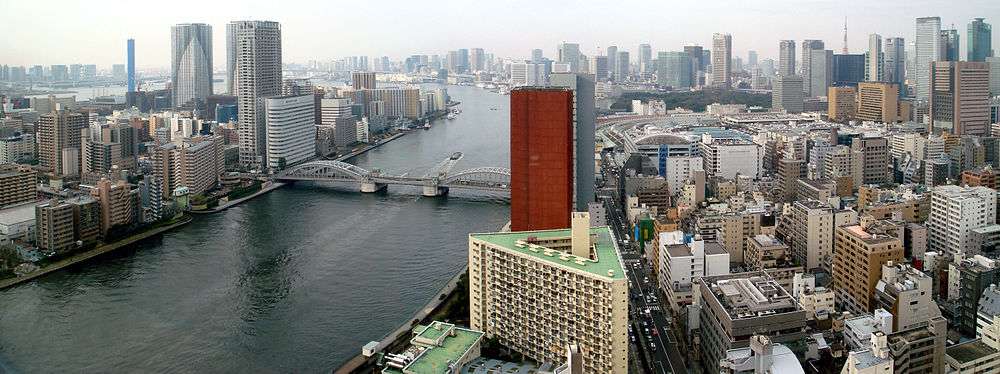
Notes
- ↑ Lincoln Center Festival, Hokaibo program notes in Playbill. July 10–29, 2007.
- ↑ See, for example, the opening lines of Records of a Weather Exposed Skeleton, published in The Narrow Road to the Deep North and Other Travel Sketches, published by Penguin Classics
- 1 2 Titsingh (1834), p. 415.
- 1 2 Koizumi Kishio: 100 Views of Great Tokyo in the Showa Era. #1
- ↑ http://myaukun.wordpress.com/2012/07/17/sumida-river-and-many-bridges-tokyo/
- ↑ Roland May: Discovering Construction as an Art – The ‘Cologne Bridge Quarrel'. Proceedings of the Third International Congress on Construction History, Cottbus, May 2009.
- ↑ http://www.ihi.co.jp/bridge/ihi_hp2006/sekoujisseki/kokunai/tsukuda/tsukuda_e.html
References
- (French) Titsingh, Isaac. (1834). Annales des empereurs du Japon. Paris: Oriental Translation Fund of Great Britain and Ireland. OCLC 251800045; see also Imprimerie Royale de France, OCLC 311322353
External links
- National Archives of Japan ...Click link for photograph of re-built Ryogoku bridge (1875)
- National Archives of Japan ...Click link for photograph of re-built Azumabashi Bridge (June 1876)
- New York Public Library Digital Gallery ...Color woodcut print of "Pleasure boating on the Sumida River", c. 1788-1790
| Wikimedia Commons has media related to Sumida River. |
Coordinates: 35°43′07″N 139°48′26″E / 35.71861°N 139.80722°E